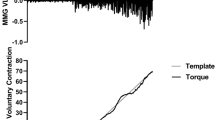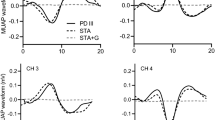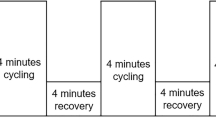Abstract
This study examined the effects of continuous endurance training on motor unit (MU) mean firing rates (MFR), percent myosin heavy chain (%MHC) isoforms, and muscle cross-sectional area (mCSA) of the vastus lateralis (VL). Twelve females completed 5-weeks of continuous cycling-training (CYC), while 8 females were controls (CON). Participants performed maximal voluntary contractions (MVCs) and 40% MVCs of the knee extensors before (PRE) and after the 5-week treatment period at the same absolute pre-treatment submaximal torque (POSTABS) and relative to post-treatment MVCs (POSTREL). Surface electromyographic (EMG) signals were decomposed with the Precision Decomposition III algorithm. MU firing times and waveforms were validated with reconstruct-and-test and spike trigger average procedures. MFRs at steady torque, recruitment thresholds (RT), and normalized EMG amplitude (N-EMGRMS) were analyzed. Y-intercepts and slopes were calculated for the MFR vs. RT relationships. MHC isoforms and mCSA were determined with muscle biopsies and ultrasonography. CYC decreased MVCs and type IIX %MHC isoform without changes in mCSA. The slopes for the MFR vs. RT relationships decreased for CYC during POSTREL and POSTABS while N-EMGRMS increased for POSTABS with no differences between PRE and POSTREL. Type I %MHC isoform was correlated with the slope for the MFR vs. RT relationship during POSTABS and POSTREL for CYC. This study provides evidence that decreases in the MFRs of higher threshold MUs post-CYC is likely a function of changes in input excitation (POSTABS) and the firing frequency–excitation relationships (POSTREL). Evidence is provided that MHC isoforms influence the firing rate scheme of the muscle following short-term training.







Similar content being viewed by others
Data availability
Data in this study are available upon request. Please contact the corresponding author for access.
Abbreviations
- CON:
-
Control treatment group
- CYC:
-
Cycling treatment group
- MU:
-
Motor unit
- MVC:
-
Maximal voluntary contraction
- EMGRMS :
-
Electromyographic amplitude
- POSTABS :
-
Post-treatment absolute torque level
- POSTREL :
-
Post-treatment relative torque level
- PRE:
-
Baseline testing
- VL:
-
Vastus lateralis
References
Amstrong L, Whaley M, Brubaker P, Otto R (2005) ACSM’Guidelines for Exercise Testing and Prescription. In: Lippincott Williams & Wilkins, American College of Sport Medicine, Guidelines Skin Fold M easurement, Philadelphia PA
Beaumont E, Gardiner PF (2003) Endurance training alters the biophysical properties of hindlimb motoneurons in rats. Muscle Nerve 27:228–236
Bellemare F, Woods J, Johansson R, Bigland-Ritchie B (1983) Motor-unit discharge rates in maximal voluntary contractions of three human muscles. J Neurophysiol 50:1380–1392
Bergstrom J (1962) Muscle electrolytes in man determined by neutron activation analysis on needle biopsy specimens. Scand J Clin Lab Investig (England) 14(Suppl 68)
Carroll CC, Gallagher PM, Seidle ME, Trappe SW (2005) Skeletal muscle characteristics of people with multiple sclerosis. Arch Phys Med Rehabil 86:224–229
Cartwright MS, Demar S, Griffin LP, Balakrishnan N, Harris JM, Walker FO (2013) Validity and reliability of nerve and muscle ultrasound. Muscle Nerve 47:515–521
Colquhoun RJ, Magrini MA, Haun CT et al (2018) Muscle phenotype is related to motor unit behavior of the vastus lateralis during maximal isometric contractions. Physiol Rep 6:e13636
Contessa P, De Luca CJ (2013) Neural control of muscle force: indications from a simulation model. J Neurophysiol 109:1548–1570
Contessa P, De Luca CJ, Kline JC (2016) The compensatory interaction between motor unit firing behavior and muscle force during fatigue. J Neurophysiol 116:1579–1585
De Luca CJ, Contessa P (2012) Hierarchical control of motor units in voluntary contractions. J Neurophysiol 107:178–195
De Luca CJ, Erim Z (1994) Common drive of motor units in regulation of muscle force. Trends Neurosci 17:299–305
De Luca CJ, Hostage EC (2010) Relationship between firing rate and recruitment threshold of motoneurons in voluntary isometric contractions. J Neurophysiol 104:1034–1046
De Luca C, LeFever R, McCue M, Xenakis A (1982a) Behaviour of human motor units in different muscles during linearly varying contractions. J Physiol 329:113–128
De Luca C, LeFever R, McCue M, Xenakis A (1982b) Control scheme governing concurrently active human motor units during voluntary contractions. J Physiol 329:129–142
De Luca CJ, Foley PJ, Erim Z (1996) Motor unit control properties in constant-force isometric contractions. J Neurophysiol 76:1503–1516
De Luca CJ, Adam A, Wotiz R, Gilmore LD, Nawab SH (2006) Decomposition of surface EMG signals. J Neurophysiol 96:1646–1657
Dimmick HL, Miller JD, Sterczala AJ, Trevino MA, Herda TJ (2018) Vastus lateralis muscle tissue composition and motor unit properties in chronically endurance-trained vs. sedentary women. Eur J Appl Physiol 118(9):1789–1800
Enoka RM, Duchateau J (2015) Inappropriate interpretation of surface EMG signals and muscle fiber characteristics impedes progress on understanding the control of neuromuscular function. J Appl Physiol 119:1516–1518
Evans W, Phinney S, Young V (1981) Suction applied to a muscle biopsy maximizes sample size. Med Sci Sports Exerc 14:101–102
Farina D, Holobar A, Gazzoni M, Zazula D, Merletti R, Enoka RM (2009) Adjustments differ among low-threshold motor units during intermittent, isometric contractions. J Neurophysiol 101:350–359
Farina D, Merletti R, Enoka RM (2014) The extraction of neural strategies from the surface EMG: an update. J Appl Physiol 117:1215–1230
Fisher RA (1921) On the “probable error” of a coefficient of correlation deduced from a small sample. Metron 1:1–32
Fry AC, Allemeier CA, Staron RS (1994) Correlation between percentage fiber type area and myosin heavy chain content in human skeletal muscle. Eur J Appl Physiol Occup Physiol 68:246–251
Fry AC, Housh TJ, Cramer JB et al (2017) Noninvasive assessment of skeletal muscle myosin heavy chain expression in trained and untrained men. J Strength Condition Res 31:2355–2362
Gardiner PF (2006) Changes in α-motoneuron properties with altered physical activity levels. Exerc Sport Sci Rev 34:54–58
Garnett R, O’donovan M, Stephens J, Taylor A (1979) Motor unit organization of human medial gastrocnemius. J Physiol 287:33–43
Grosicki GJ, Standley RA, Murach KA et al (2016) Improved single muscle fiber quality in the oldest-old. J Appl Physiol 121:878–884
Grottel K, Celichowski J, Anissimova N (1993) The relationship between the stimulation frequency and the tension of rat medial gastrocnemius motor units. Roczniki Naukowe AWF (poznan) 42:73–80
Harber MP, Gallagher PM, Creer AR, Minchev KM, Trappe SW (2004) Single muscle fiber contractile properties during a competitive season in male runners. Am J Physiol Regul Integr Compar Physiol 287:R1124–R1131
Harridge S, Bottinelli R, Canepari M, Pellegrino M, Reggiani C, Esbjörnsson M, Saltin B (1996) Whole-muscle and single-fibre contractile properties and myosin heavy chain isoforms in humans. Pflugers Arch 432:913–920
Herda TJ, Siedlik J, Trevino MA, Cooper MA, Weir JP (2015) Motor unit control strategies of endurance versus resistance trained individuals. Muscle Nerve 52(5):832–843
Herda TJ, Trevino MA, Sterczala AJ et al (2019) Muscular strength and power are correlated with motor unit action potential amplitudes, but not myosin heavy chain isoforms in sedentary males and females. J Biomech 86:251–255
Herda TJ, Parra ME, Miller JD, Sterczala AJ, Kelly MR (2020) Measuring the accuracies of motor unit firing times and action potential waveforms derived from surface electromyographic decomposition. J Electromyogr Kinesiol 52:102421
Howald H, Hoppeler H, Claassen H, Mathieu O, Straub R (1985) Influences of endurance training on the ultrastructural composition of the different muscle fiber types in humans. Pflugers Arch 403:369–376
Hu X, Rymer WZ, Suresh NL (2013) Motor unit pool organization examined via spike-triggered averaging of the surface electromyogram. J Neurophysiol 110:1205–1220
Karvonen MJ, Kentala E, Mustala O (1957) The effects of training on heart rate; a longitudinal study. Ann Med Exp Biol Fenn 35:307
Lexell J, Henriksson-Larsen K, Sjöström M (1983) Distribution of different fibre types in human skeletal muscles 2. A study of cross-sections of whole m. vastus lateralis. Acta Physiol Scand 117:115–122
Lounana J, Campion F, Noakes TD, Medelli J (2007) Relationship between% HRmax,% HR reserve,% VO2max, and% VO2 reserve in elite cyclists. Med Sci Sports Exerc 39:350–357
Majerczak J, Karasinski I, Zoladz A (2008) Training induced decrease in oxygen cost of cycling is accompanied by down regulation of SERCA expression in human vastus lateralis muscle. Acta Physiol Pol 59:589
Martinez Valdes E, Negro F, Falla D, De Nunzio AM, Farina D (2018) Surface EMG amplitude does not identify differences in neural drive to synergistic muscles. J Appl Physiol (1985) 124(4):1071–1079
Martinez-Valdes E, Falla D, Negro F, Mayer F, Farina D (2017) Differential motor unit changes after endurance or high-intensity interval training. Med Sci Sports Exerc 49(6):1126–1136
Miller JD, Lippman JD, Trevino MA, Herda TJ (2020) Neural drive is greater for a high-intensity contraction than for moderate-intensity contractions performed to fatigue. J Strength Condition Res 34:3013–3021
Milner-Brown HS, Stein RB, Yemm R (1973) Changes in firing rate of human motor units during linearly changing voluntary contractions. J Physiol 230:371–390
Nawab SH, Chang SS, De Luca CJ (2010) High-yield decomposition of surface EMG signals. Clin Neurophysiol 121:1602–1615
Norton K, Norton L, Sadgrove D (2010) Position statement on physical activity and exercise intensity terminology. J Sci Med Sport 13:496–502
Person RS, Kudina LP (1972) Discharge frequency and discharge pattern of human motor units during voluntary contraction of muscle. Electroencephalogr Clin Neurophysiol 32:471–483
Pope ZK, Hester GM, Benik FM, DeFreitas JM (2016) Action potential amplitude as a non-invasive indicator of motor unit specific hypertrophy. J Neurophysiol 00039:02016
Rowan SL, Rygiel K, Purves-Smith FM, Solbak NM, Turnbull DM, Hepple RT (2012) Denervation causes fiber atrophy and myosin heavy chain co-expression in senescent skeletal muscle. PLoS ONE 7:e29082
Saltin B, Gollnick PD (1983) Skeletal muscle adaptability: significance for metabolism and performance. In: Handbook of Physiology. Skeletal Muscle pp 555–631
Schilling BK, Fry AC, Weiss LW, Chiu LZ (2005) Myosin heavy chain isoform expression: influence on isoinertial and isometric performance. Res Sports Med 13:301–315
Scott JM, Martin DS, Ploutz-Snyder R et al (2012) Reliability and validity of panoramic ultrasound for muscle quantification. Ultrasound Med Biol 38:1656–1661
Staron RS, Johnson P (1993) Myosin polymorphism and differential expression in adult human skeletal muscle. Compar Biochem Physiol Part B: Compar Biochem 106:463–475
Staron R, Malicky E, Leonardi M, Falkel J, Hagerman F, Dudley G (1990) Muscle hypertrophy and fast fiber type conversions in heavy resistance-trained women. Eur J Appl Physiol 60:71–79
Staron RS, Hagerman FC, Hikida RS et al (2000) Fiber type composition of the vastus lateralis muscle of young men and women. J Histochem Cytochem 48:623–629
Swain DP (2000) Energy cost calculations for exercise prescription. Sports Med 30:17–22
Tanji J, Kato M (1973) Firing rate of individual motor units in voluntary contraction of abductor digiti minimi muscle in man. Exp Neurol 40:771–783
Thompson CK, Negro F, Johnson MD et al (2018) Robust and accurate decoding of motoneuron behaviour and prediction of the resulting force output. J Physiol 596:2643–2659
Trappe S, Gallagher P, Harber M, Carrithers J, Fluckey J, Trappe T (2003) Single muscle fibre contractile properties in young and old men and women. J Physiol 552:47–58
Trevino MA, Herda TJ, Fry AC, Gallagher PM, Vardiman JP, Mosier EM, Miller JD (2016) Influence of the contractile properties of muscle on motor unit firing rates during a moderate-intensity contraction in vivo. J Neurophysiol 116:552–562
Trevino MA, Sterczala AJ, Miller JD et al (2018) Sex-related differences in muscle size explained by amplitudes of higher-threshold motor unit action potentials and muscle fiber typing. Acta Physiol 225:e13151
Trevino M, Sterczala A, Miller J et al (2019) Sex-related differences in muscle size explained by amplitudes of higher-threshold motor unit action potentials and muscle fibre typing. Acta Physiol 225:e13151
Vila-Cha C, Falla D (2010) Farina D (2010) Motor unit behavior during submaximal contractions following six weeks of either endurance or strength training. J Appl Physiol (1985) 109:1455–1466
Walter AA, Herda TJ, Ryan ED et al (2009) Acute effects of a thermogenic nutritional supplement on cycling time to exhaustion and muscular strength in college-aged men. J Int Soc Sports Nutr 6:15
Williamson D, Gallagher P, Carroll C, Raue U, Trappe S (2001) Reduction in hybrid single muscle fiber proportions with resistance training in humans. J Appl Physiol 91:1955–1961
Acknowledgements
We would like to thank P.R. Maier and J.D. Lippman who aided in data collection and analysis, as well as each subject for their selfless participation.
Funding
This publication was made possible by a National Strength and Conditioning Association Foundation (NSCAF) Graduate Research Doctoral Grant FND0074499 and a University of Kansas Doctoral Student Research Fund (DSRF) grant.
Author information
Authors and Affiliations
Contributions
MAT and TJH designed the experiments, MAT, AJS, JDM, MEW, HLD, JAD, JPW, ACF, and PMG conducted the experiments, MAT, AJS, JDM, MEW, HLD, JAD, JPW, ACF, PMG, and TJH analyzed the data. MAT wrote the manuscript. MAT, TJH, ACF, and PMG edited and revised the manuscript. All authors approved the final version of the manuscript submitted for publication and agree to be accountable for all aspects of the work. All persons designated as authors qualify for authorship, and all those who qualify for authorship are listed.
Corresponding author
Ethics declarations
Conflict of interest
The authors declare they have no competing interests.
Ethics approval
University of Kansas-Lawrence Institutional Review Board (# STUDY00002953).
Additional information
Communicated by Bill J Yates.
Publisher's Note
Springer Nature remains neutral with regard to jurisdictional claims in published maps and institutional affiliations.
Rights and permissions
About this article
Cite this article
Trevino, M.A., Dimmick, H.L., Parra, M.E. et al. Effects of continuous cycling training on motor unit firing rates, input excitation, and myosin heavy chain of the vastus lateralis in sedentary females. Exp Brain Res 240, 825–839 (2022). https://doi.org/10.1007/s00221-021-06278-3
Received:
Accepted:
Published:
Issue Date:
DOI: https://doi.org/10.1007/s00221-021-06278-3




